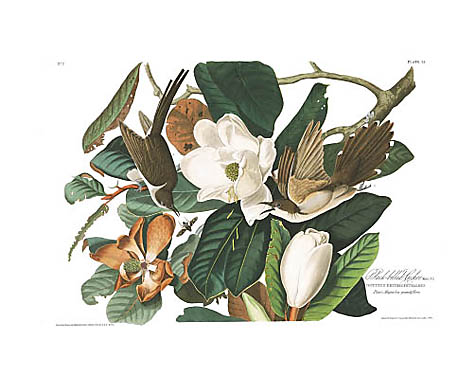|
||||||||||||||||||||
|
||||||||||||||||||||
|
|
||||||||||||||||||||
|
Ornithological Biography I have not met with this species in the State of Louisiana more than half a dozen times; nor indeed have I seen it at all in the Western States, excepting that of Ohio, where I have occasionally observed an individual, apparently out of its usual range. Some of these individuals were probably bound for the Upper Lakes. The woody sides of the sea are the places to which this species usually resorts. It passes from the south early in March, and continues its route through Florida, Georgia, and all the other States verging on the Atlantic, beginning to rest and to breed in North Carolina, and extending its travels to the Province of Maine.
The flight of this species is swifter than that of its near relative, the Yellow-billed Cuckoo, for which bird it is easily mistaken by ordinary observers. It does not so much frequent the interior of woods, but appears along their margins, on the edges of creeks and damp places. But the most remarkable distinction between this species and the Yellow-billed Cuckoo, is, that the former, instead of feeding principally on insects and fruits, procures fresh-water shellfish and aquatic larvae for its sustenance. It is, therefore, more frequently seen on the ground, near the edges of the water, or descending along the drooping branches of trees to their extremities, to seize the insects in the water beneath them. The nest of this bird is built in places similar to those chosen by the other species, and is formed of the same materials, arranged with quite as little art. The females lay from four to six eggs, of a greenish-blue, nearly equal at both ends, but rather smaller than those of the Yellow-billed Cuckoo. It retires southward fully a fortnight before the latter. The observations respecting the curious manners of our Yellow-billed Cuckoo, the subject of the last article, might be repeated here, for the present species is similar in this respect, as has been ascertained by Dr. T. M. BREWER of Boston. Its eggs are not only smaller than those of the other species, but also rounder, and of a much deeper tint of green; they measure one inch and half an eighth in length, and seven-eighths in breadth. The Black-billed Cuckoo is rare in all the Southern States, my friend Dr. BACHMAN never having seen it in the maritime districts of South Carolina, nor myself in any part of Georgia, although WILSON, who first distinguished this Species, says that Mr. ABBOT of Georgia found it there, and was well aware of its being distinct from the yellow-billed species. I met with it in Texas, arriving from the south; and found some individuals in winter, in the central parts of the southern districts of Florida. On the other hand, it is not uncommon in Nova Scotia and Newfoundland, and we saw a few in Labrador, amid the clumps of low trees a few miles from the shore of the Gulf in secluded and pleasant valleys. It does not appear that it reaches the Fur Countries, or the Rocky Mountains, as no mention is made of it by Dr. RICHARDSON or Mr. TOWNSEND. It being so scarce a species in Louisiana, I have honoured it by placing a pair on a branch of magnolia in bloom, although the birds represented were not shot on one of these trees, but in a swamp near some, where the birds were in pursuit of such flies as you see figured, probably to amuse themselves. |
||||||||||||||||||||
|
|
||||||||||||||||||||


| Home | Gallery | Audubon Biography | About Edition | Testimonials | Authorized Dealers | Links | Contact Us |

© Copyright 2007-2025 Zebra Publishing, LLC. | All Rights Reserved Terms of Use
Powered by Fusedog Media Group
